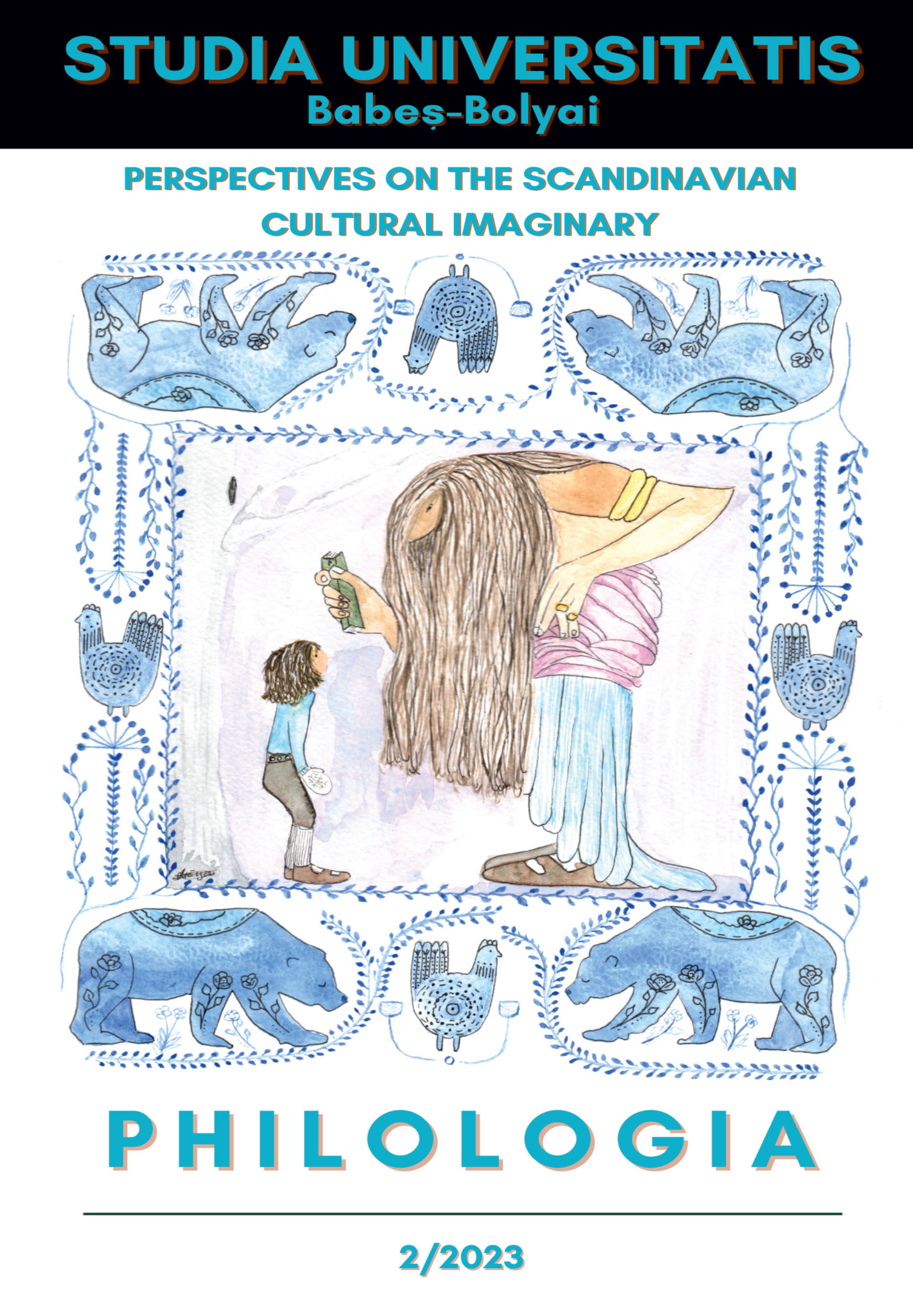WEAK AND STRONG ADJECTIVES IN OLD NORSE: AN EXAMINATION OF „KONUNGS SKUGGSJÁ”
DOI:
https://doi.org/10.24193/subbphilo.2023.2.01Keywords:
weak adjectives, strong adjectives, Old Norse, Konungs skuggsjá, determinersAbstract
Weak and Strong Adjectives in Old Norse: An Examination of Konungs skuggsjá. All early Germanic languages distinguish between a weak and a strong adjectival declension. This contrast is traditionally described in terms of definiteness, the strong declension expressing indefinite reference and the weak one definite reference. Such a description, however, might be more suitable with regard to Modern Scandinavian languages than to Old Norse (and other early Germanic languages), where the strong declension is found in a number of contexts where in Modern Norwegian only the weak one is acceptable, for instance with certain demonstratives and in noun phrases with possessives. This article takes a look at the Old Norse didactic work Konungs skuggsjá and examines various contexts that unambiguously require the weak declension in Modern Norwegian: demonstratives, possessives, proper nouns, vocatives and others. The role and referential properties of the determiners sá and hinn are given special focus.
REZUMAT. Adjective slabe și tari în limba norvegiană veche: o analiză a textului Konungs skuggsjá. Toate limbile germanice timpurii se diferențiază prin două tipuri de declinare adjectivală: a adjectivelor slabe și a celor tari. Acest contrast este descris în mod tradițional pornind de la tipul articolului folosit, declinarea tare făcând trimitere la referința nearticulată și cea slabă, la referința articulată. O astfel de descriere, totuși, ar putea fi mai potrivită pentru limbile scandinave moderne decât pentru limba norvegiană veche (și alte limbi germanice timpurii), în care declinarea tare se găsește într-o serie de contexte. În contrast, în limba norvegiană modernă, se acceptă doar cea slabă, de exemplu cu anumite demonstrative și în sintagmele nominale cu posesive. Acest articol prezintă textul didactic Konungs skuggsjá din limba norvegiană veche și analizează o serie de contexte care necesită în mod cert declinarea slabă în limba norvegiană modernă: demonstrative, posesive, substantive proprii, vocative și altele. Rolului și proprietăților referențiale ale determinanților sá și hin li se acordă o atenție deosebită.
Cuvinte-cheie: adjective, limba norvegiană veche, Konungs skuggsjá, determinanți sá, hinnArticle history: Received 2 February 2023; Revised 28 April 2023; Accepted 30 May 2023; Available online 23 June 2023; Available print 30 June 2023.
References
Primary source:
Konungs skuggsjá, AM 243 b a fol. URL: https://clarino.uib.no/menota/document-element?session-id=254903757448439&cpos=323433
Secondary sources:
Abraham, Werner. 2007. "Discourse binding: DP and pronouns in German, Dutch, and English." In Nominal determination. Typology, context constraints, and historical emergence, edited by Elisabeth Stark, Elisabeth Leiss and Werner Abraham, 21–48. Amsterdam: John Benjamins.
Delsing, Lars-Olof. 1994. "’Hans sjukt ben’ - Om starka och svaga adjektiv i fornsvenskan." In Språkbruk, grammatik och språkförändring: En festskrift till Ulf Teleman 13.1.1994, 99–108. Lund.
Dyvik, Helge. 1979. "Omkring fremveksten av artiklene i norsk. Språklig markering av referensielle forutsetninger." Maal og Minne 1-2 1979: 40–78.
Faarlund, Jan Terje, Svein Lie and Kjell Ivar Vannebo. 1997. Norsk referansegrammatikk. Oslo: Universitetsforlaget.
Faarlund, Jan Terje. 2004. The syntax of Old Norse. Oxford: Oxford University Press.
Faarlund, Jan Terje. 2009. "On the history of definiteness marking in Scandinavian." Journal of Linguistics 45, no. 3: 617–639.
Harðarson, Jón Axel. 2017. "55. The morphology of Germanic". In Volume 2 Handbook of Comparative and Historical Indo-European Linguistics: An International Handbook, edited by Jared Klein, Brian Joseph and Matthias Fritz, 913–954. Berlin, Boston: De Gruyter Mouton.
Heggstad, Leiv, Finn Hødnebø and Erik Simensen. 2012. Norrøn ordbok. Oslo: Det norske samlaget.
Jónsson, Finnur. 1926. Kongespejlet. København: Gyldendal.
Julien, Marit. 2014. "Vokativar i norsk." Norsk Lingvistisk Tidsskrift 32, no. 1: 130–165.
Kristoffersen, Kristian Emil. 2002. "103. The morphology of Old Nordic I: Old Icelandic and Old Norwegian". In The Nordic Languages. An international handbook of the history of the North Germanic languages. Vol. 1, edited by Oskar Bandle et al., 911–925. Berlin, Boston: De Gruyter Mouton.
Leiss, Elisabeth. 2000. Artikel und Aspekt: die grammatischen Muster von Definitheit. Berlin: De Gruyter Mouton.
Lindblad, Gustaf. 1953. "Den äldsta nordiska relativkonstruktionen." In Arkiv för nordisk filologi: 68–69.
Lundeby, Einar. 1965. Overbestemt substantiv i norsk. Oslo: Universitetsforlaget.
Lyons, Christopher. 1999. Definiteness. Cambridge: Cambridge University Press.
Nygaard, Marius. 1905. Norrøn Syntax. Kristiania: Aschehoug.
Ratkus, Arturas. 2011. The Adjective Inflection in Gothic and Early Germanic: Structure and Development. Unpublished PhD-dissertation, University of Cambridge.
Ringe, Don. 2006. A Linguistic History of English. Volume I. From Proto-Indo-European to Proto-Germanic. Oxford: Oxford University Press.
Seip, Didrik Arup. 1955. Norsk språkhistorie til omkring 1370. Oslo: Aschehoug.
Skrzypek, Dominika. 2012. Grammaticalization of (in)definiteness in Swedish. Poznan: WydawnictwoNaukowe UAM.
Stroh-Wollin, Ulla. 2009. "On the development of definiteness markers in Scandinavian." In Working Papers in Scandinavian Syntax: 1–25. Lund: Lund University.
Wagener, Terje. 2017. The history of Nordic relative clauses. Berlin: De Gruyter Mouton.
Wellendorf, Jonas. 2013. "Lærdomslitteratur." In Handbok i norrøn filologi, edited by Odd Einar Haugen, 302–355. Bergen: Fagbokforlaget.
Downloads
Published
How to Cite
Issue
Section
License
Copyright (c) 2023 Studia Universitatis Babeș-Bolyai Philologia

This work is licensed under a Creative Commons Attribution-NonCommercial-NoDerivatives 4.0 International License.





 ©Studia Universitatis Babeş-Bolyai Philologia. Published by Babeș-Bolyai University.
©Studia Universitatis Babeş-Bolyai Philologia. Published by Babeș-Bolyai University.